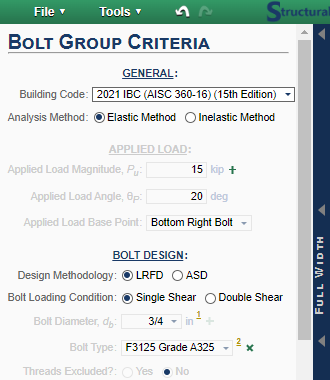| Bolt Group Tool Features |
Elastic and Inelastic Methods | The two most common analysis methods for bolted connections are included, so you can select whichever method applies to your design. The procedures for both of these methods are as described in Part 7 of the Steel Construction Manual produced by the American Institute of Steel Construction (AISC). |
Analyze or Design | The calculations automatically adjust, based on your input, to be just for analysis or also design. The ratio of the applied load to the maximum bolt reaction is always determined, but if you also provide the design load, the minimum bolt diameter will be found. Alternatively, you can provide the bolt diameter, and then the stresses in the bolts will be calculated instead. |
Design Code | Calculate bolt capacities per the Specification for Structural Steel Buildings (ANSI/AISC 360) which is the Referenced Standard for steel design of the International Building Code (IBC). |
Design Criteria | Determine the strength of the bolts using Load and Resistance Factor Design (LRFD) or Allowable Strength Design (ASD), loaded in single or double shear. The shear strength of the bolts will use the preferred material specification (ASTM F3125 Grade A325) by default, or you can select another common specification, or just set the nominal shear stress, Fnv, directly. |
Factored or Unfactored Loads | The applied load can be entered as either a single load or as multiple loads with different load types (Dead, Live, Wind, etc). Multiple loads will be combined automatically using the LRFD or ASD load combinations provided by Chapter 16 of the International Building Code. |
Instant Results | The inelastic method, or instantaneous center of rotation method, is normally an iterative procedure that requires guessing many points of rotation until equilibrium is met. The Bolt Group Tool includes an algorithm for identifying this location automatically, so you don't have to. |




